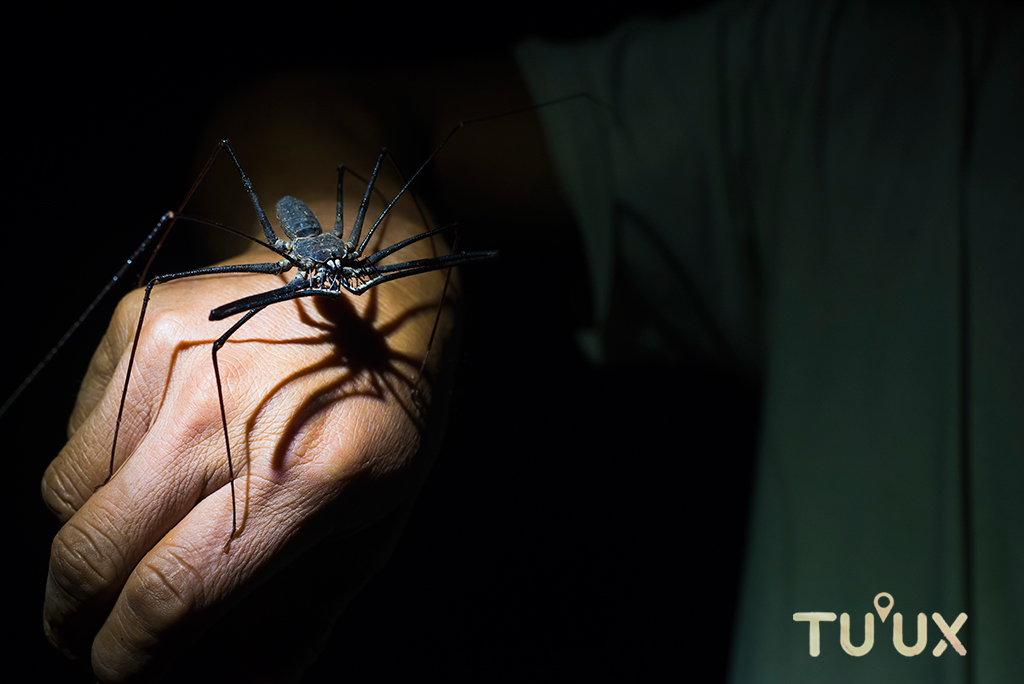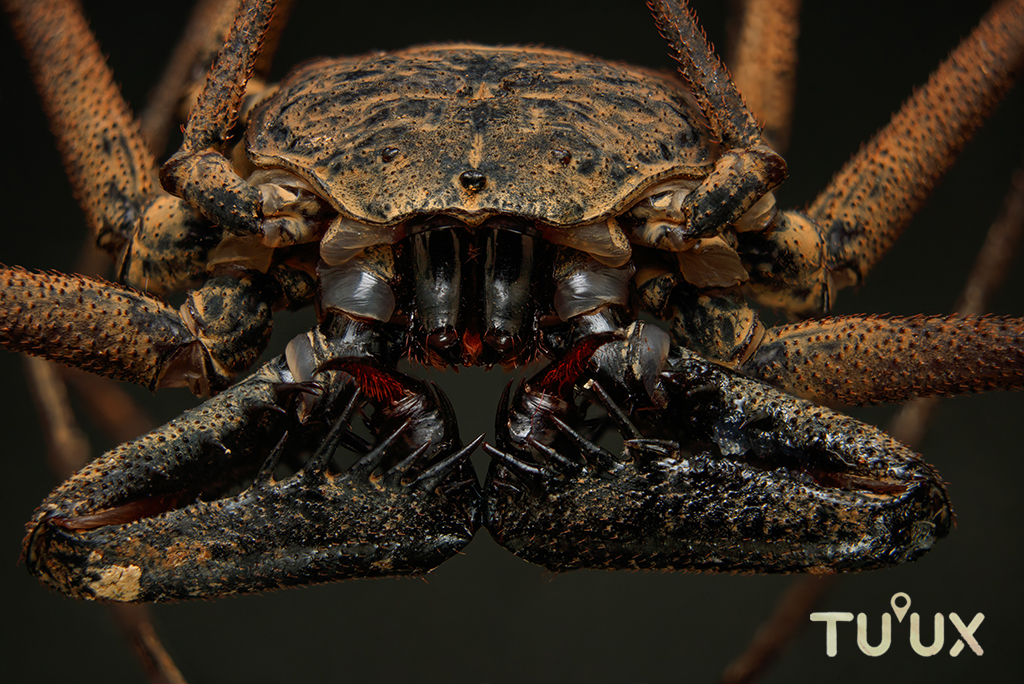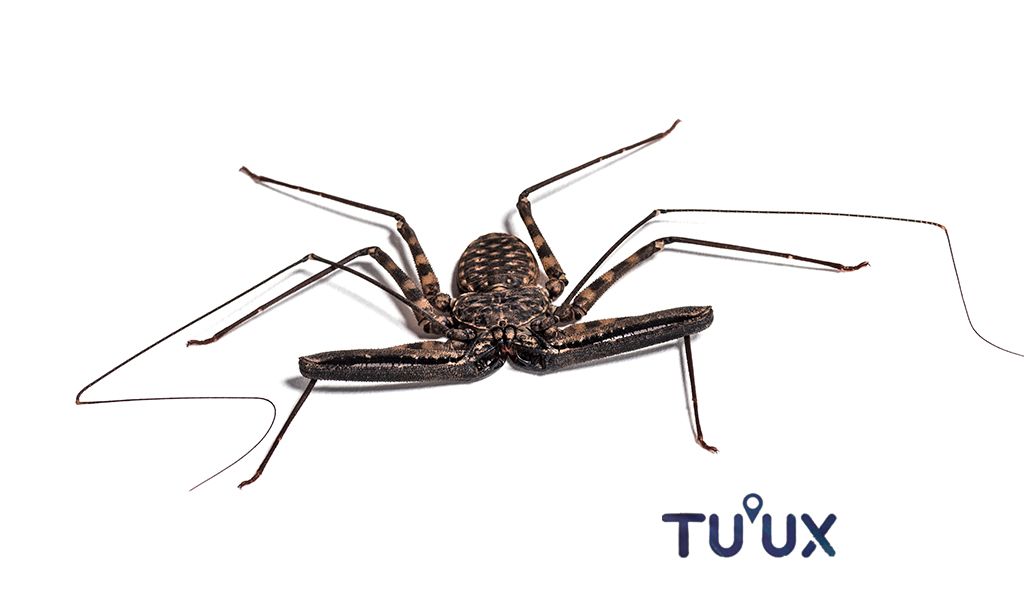AMBLYPYGI
🌒 El Enigmático Cazador de la Noche Tropical
Silencioso, ágil y absolutamente inofensivo, el Amblypygi se desliza como una sombra ancestral entre la hojarasca y los troncos podridos de la selva. Conocido popularmente como araña látigo o escorpión látigo sin aguijón, este arácnido de aspecto alienígena es una joya de la evolución que habita en los rincones más húmedos y oscuros del planeta.
🕷️ ¿Qué es un Amblypygi?
El nombre Amblypygi proviene del griego y significa “mandíbula roma”, aludiendo a sus quelíceros que, lejos de ser armas ofensivas, funcionan como herramientas para capturar presas con sorprendente precisión. Aunque se le compare con arañas o escorpiones, pertenece a un orden único de arácnidos, con una historia evolutiva que se remonta a cientos de millones de años.
Su cuerpo plano y patas largas lo convierten en un acróbata del inframundo selvático. El primer par de patas no se utiliza para caminar, sino que actúa como una especie de antena táctil, permitiéndole “ver” su entorno incluso en completa oscuridad.
🔍 Características Físicas
- 📏 Tamaño: Puede alcanzar hasta 45 cm de envergadura si se cuentan sus patas sensoriales.
- 🎨 Coloración: Marrón oscuro o negruzco, ideal para camuflarse entre sombras y grietas.
- 👀 Visión: Pobre. Posee un par de ojos medianos al frente y varios laterales, pero depende casi por completo del tacto.
- ❌ Sin aguijón ni veneno: No muerde, no pica, no representa ningún peligro para los humanos.
⚠️ A pesar de su apariencia, el Amblypygi no debe ser temido. Es completamente inofensivo y tímido ante la presencia humana.
🌙 Comportamiento Nocturno
El Amblypygi es un depredador nocturno discreto. Con movimientos casi hipnóticos, explora su territorio al amparo de la oscuridad. Su principal técnica de caza se basa en el sigilo y la precisión.
Cuando detecta una presa —como grillos, cucarachas o escarabajos—, la atrapa en un rápido movimiento con sus pedipalpos espinosos, similares a tenazas. Esta eficiencia lo convierte en un regulador natural de insectos en su entorno.
🏞️ Hábitat y Distribución
Este arácnido habita en zonas tropicales y subtropicales de América, África, Asia y Australia. Es común encontrarlo:
- En cuevas húmedas y profundas.
- Bajo troncos en descomposición.
- En hojarasca densa.
- En paredes de cenotes y cavernas mayas, especialmente en el sureste de México.
🌿 En Mahahual, Quintana Roo, su presencia es habitual en zonas selváticas cercanas al litoral, donde forma parte integral del ecosistema nocturno.
🌱 Importancia Ecológica
Lejos de ser un simple “bicho raro”, el Amblypygi cumple una función ecológica fundamental:
- Controlador de plagas: Regula poblaciones de insectos que podrían ser nocivos para humanos o cultivos.
- Indicador ambiental: Su presencia denota buena calidad ambiental, ya que necesita altos niveles de humedad y estabilidad ecológica para sobrevivir.
🌟 Curiosidades Fascinantes
🍼 Cuidado maternal: Las crías nacen en una membrana que la madre protege hasta que se rompen. Luego suben a su lomo y permanecen ahí hasta su primera muda.
🎥 Estrella del cine: Apareció en Harry Potter y el Cáliz de Fuego, provocando escalofríos innecesarios gracias a su aspecto, no a su comportamiento.
🧠 Inspiración para la ciencia: Su forma de navegación ha sido estudiada en proyectos de neurociencia y robótica, debido a su extraordinaria capacidad sensorial.
🙌 Desmitificando su Imagen
A pesar de su aspecto que podría evocar criaturas de ciencia ficción, el Amblypygi no muerde, no pica, no es venenoso, y huye del contacto humano. Su figura es más temida por ignorancia que por hechos reales.
🌌 Ver uno en la naturaleza debería despertar nuestra admiración, no nuestro miedo.
🛡️ Conservación y Respeto
Como muchos habitantes de los ecosistemas tropicales, el Amblypygi enfrenta amenazas derivadas de la deforestación, la pérdida de hábitat y el miedo humano. Es vital fomentar su protección y valoración:
✅ No lo mates.
✅ No lo retires de su entorno.
✅ Obsérvalo con respeto.
📝 Conclusión
El Amblypygi es un testimonio viviente del ingenio de la naturaleza, una criatura antigua, precisa, y profundamente conectada con la salud del entorno que habita. La próxima vez que te adentres en la selva y sientas que alguien más se mueve en la oscuridad… podría ser este extraño, elegante y tímido habitante nocturno.


🌒 Amblypygi: The Enigmatic Night Hunter of the Tropics
Silent, agile, and absolutely harmless, the Amblypygi glides like an ancient shadow among decaying logs and leaf litter in the rainforest. Commonly referred to as a whip spider or tailless whip scorpion, this alien-looking arachnid is an evolutionary marvel that thrives in some of the darkest and dampest corners of the planet.
🕷️ What is an Amblypygi?
The name Amblypygi comes from Greek and means “blunt mandible,” referring to its chelicerae—small appendages used for capturing prey rather than biting. Despite its nickname, it is neither a spider nor a scorpion. It belongs to an entirely separate order of arachnids with a lineage that dates back hundreds of millions of years.
Its flat body and elongated legs make it a master of tight spaces and vertical climbs. Its first pair of legs, instead of being used for walking, have evolved into sensory antennae, allowing it to “see” the world through touch.
🔍 Physical Characteristics
- 📏 Size: Up to 45 cm (18 inches) across, including its long sensory legs.
- 🎨 Coloration: Dark brown or blackish tones, ideal for blending into the shadows.
- 👀 Eyesight: Poor. It has a pair of median eyes and several lateral ones but relies heavily on touch.
- ❌ No venom or stinger: It cannot bite, sting, or harm humans in any way.
⚠️ Despite its appearance, the Amblypygi is completely harmless. It poses no threat to humans and is extremely shy.
🌙 Nocturnal Behavior
Amblypygids are stealthy nocturnal predators. Under the cover of darkness, they explore their surroundings with ghostlike movements. Their hunting technique is both fascinating and effective.
When they detect a prey—usually crickets, cockroaches, or beetles—they swiftly capture it with their spiny pedipalps, which function like pincers. This makes them highly effective natural pest controllers.
🏞️ Habitat and Distribution
These arachnids thrive in tropical and subtropical regions of the Americas, Africa, Asia, and Australia. They are commonly found:
- In damp caves and crevices.
- Beneath rotting logs and bark.
- Among dense leaf litter.
- Along the walls of cenotes and limestone caves, particularly in southeastern Mexico.
🌿 In places like Mahahual, Quintana Roo, Amblypygids are part of the rich nocturnal ecosystem of the coastal jungle.
🌱 Ecological Importance
Far from being a mere “creepy crawly,” the Amblypygi plays a vital ecological role:
- Pest control: Keeps insect populations in check, including some that are harmful to crops or human health.
- Environmental indicator: Their presence signifies a healthy habitat, as they require stable, humid ecosystems to survive.
🌟 Fascinating Curiosities
🍼 Maternal care: Some species exhibit surprising social behavior. After hatching, the tiny offspring climb onto the mother’s back and stay there until their first molt.
🎥 Pop culture appearance: Featured in Harry Potter and the Goblet of Fire, contributing to their undeserved scary reputation.
🧠 Scientific interest: Their navigational skills make them ideal subjects for neuroscience and robotics research.
🙌 Debunking the Fear
Despite their intimidating appearance, Amblypygids are completely harmless, non-aggressive, and non-venomous. They shy away from humans and are rarely seen during the day.
🌌 Spotting one in the wild should inspire curiosity, not fear.
🛡️ Conservation and Respect
Like many tropical species, Amblypygids face threats from deforestation, habitat loss, and human misunderstanding. It is essential to foster respect and conservation awareness:
✅ Do not kill them.
✅ Do not remove them from their habitat.
✅ Observe from a distance and appreciate their role in nature.
📝 Final Thoughts
The Amblypygi is a living testament to nature’s ingenuity—a precise, ancient creature deeply tied to the health of its environment. Next time you wander through a rainforest trail at night and catch a glimpse of something surreal in the shadows… you might just be in the presence of this remarkable and misunderstood night dweller.







